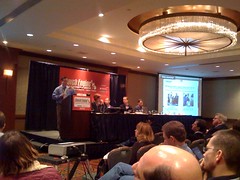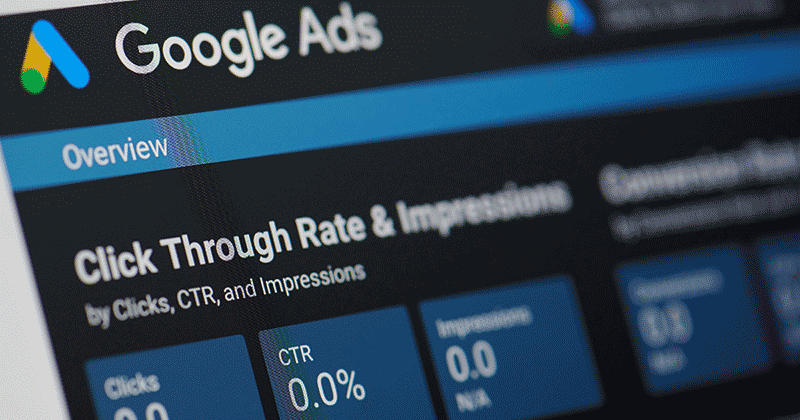Advanced B2B
 |
This session’s moderator is Rebecca Lieb, VP of U.S. operations for Econsultancy. Our speakers are: Scott Brinker, president and CTO of ion interactive; Kevin Lee, co-founder and executive chairman of Didit; Ian Harris, CEO of Search Laboratory Ltd; and Adam S. Goldberg, chief innovation officer of ClearSaleing.
Scott Brinker is up first. He specializes in post-click marketing — landing pages and conversion paths, everything after the click.
4 Reasons Why Segmentation Matters
- Complex offerings, many value propositions.
- Multiple people involved in the sales process.
- Long sales cycles with multiple stages.
- Wide disparity between best and worst customers.
Segmentation granularity as a strategy: It’s becoming easier to increase the granularity of interactions between specific people. Segmentation can happen through keywords and ad creatives; landing page behavioral choices; IP address profiling; forms on the landing page or the site; site-wide behavioral analysis. The first two are self-selected and incentivized. The others might be transparent, but not likely incentivized.
When you’re segmenting by keywords, you shouldn’t just have one landing page, but many landing pages. How many is determined by how many you can manage and deploy cost effectively and still generate ROI. Clients that go from generic landing pages to specific landing pages can see a four time growth in conversion rates.
A landing page that’s a form including a drop down menu is a poor example. The form is actually the conversion, so you shouldn’t have that up front. Instead they changed it to a landing page that had a targeted message that made it clear what they were getting when they filled out the form. They also streamlined the form.
Landing pages can have more than one page.
They can have a conversion path type structure with segmentation choices on the page they land on. If you’re audience is businesses, there could be big differences between small- and medium-size businesses and enterprise businesses. Sharing the same message to both audiences waters the message down or, worse, turns off one of the audience groups. When given the choice to segment which group they were in, 65 percent of users chose their group and they saw a 14 percent conversion rate. This way you can figure out which segments convert best.
How many pages can you have in a landing page?
It depends on what you’re talking about. You may need fewer pages for users that are already customers and more pages to educate people who are unfamiliar with your business. You get a lot of data this way as well.
He’s got a book called “Honest Seduction” that has a lot more in-depth info.
Kevin Lee is up next and he’s focusing on ads. He asks how many are running Google AdWords — almost everyone. A few more hands drop when he asks if they are using Yahoo. Only a few are left up when he asks about Live. He thinks that if you’re not in Yahoo and Live you’re missing a chunk of your audience.
B2B search challenges
- Difficult to pre-select B2B clickers
- No single decision maker
- Offline conversions
- Long lead time and lagged conversions
- Keywords are often not B2B specific
- Huge range in lead quality and lifetime value
Which searchers want to buy? You have the prospects coming in. You think they came in to get out of the rain? A guy doesn’t walk on the lot unless he wants to buy. They’re sitting out there waiting to give you their money. Are you going to take it? (paraphrased from Glengarry Glen Ross)
Media auctions can be painful — the winner’s curse. Success requires figuring out how to either: a) be the brilliant marketer or b) challenge the irrational bidder. Which is your competition?
Post-click activities might be included in your list of success metrics at different values. Lead forms/white paper requests/newsletter registrations; visits to the “contact us” page; phone calls (tracking at the keyword level). Targeting landing pages dynamically based on IP address or reverse DNS can help deal with B2B uncertainty.
When the keyword alone doesn’t work, the other predictors are:
- Search engine
- Daypart
- Day of the week
- Geography
- IP address and ISP (not targetable in search)
Each is an additional segment you can analyze to cherry-pick the best audience. Each segment with the possibility to drive scale should be considered for separate bidding and targeting.
Other specific solutions for B2B:
- Custom-serving landing page based on IP blog, ISP, cookie
- Click routing
- Integration of automated or manual proactive chat if lead value is high and traffic mix is good
- Heavy use of retargeting campaigns for sticky visitors who are more likely to really be B2B
Ian Harris is going to talk about the PPC process:
The major issue he comes across with B2B is terminology. Everyone wants to call what they do something different than what the average searcher will look for. Marketing teams are uncomfortable letting go of the name they’ve created.
The risks are higher with B2B than B2C because in the former, people can lose jobs and a lot of money can be lost. The B2B sale is more complex. A salesperson is needed. The prospect is not ready and there is prospect fear. There is a long time to order. So what to do?
Set Up Phase
- Product/service
- Competition
- Differentiators
- Target organizations
- Target person
Take time on the set up and it will pay off later. Understand how to sell and have the top sales person involved in the set up phase. They know the key selling points that resonate with potential buyers.
Conversion
- Education
- Research
- Shortlist
Post-Analyze
Conversions are not sales. Because you’re giving something away, there are probably some nonsense conversions. You have to take out the bad email addresses and phone numbers. As you go through the sales process the numbers get fewer and fewer. But you have to retain and find out the performance of keywords, ads, landing pages and conversion offer. Certain keywords cause more rubbish than others. But don’t look at how much garbage it causes but how many good conversions you’re getting.
Summary
- Take time to set up
- Understand how to sell
- Understand buying stages and connect
- Use qualifying conversions
- Analyze conversion quality
- Don’t translate — localize properly
Adam Goldberg is going to share next. He says that leads become opportunities that convert into profitable business. We don’t talk about profit enough when that’s really all that matters. He sets up a scenario where a business compares the cost per lead across the big three search engines. But that’s a bad focus point because even though the lead may cost more, you may get more sales per lead and a lower cost per acquisition. It goes even further that you get more profit from a lead that cost a little more up front.
Since this is an advanced panel, you’re going to need tools and sources to help you. You need a program where you can funnel in all your data and you can find out which leads close deals.
Phone Call Tracking
Phone calls are a big part of a B2B’s business. He’s not a fan of a band of 800 numbers with each dedicated to a keyword. It’s too much to manage. Instead he prefers two other methods. A number on the site itself is delivered to each user on the site. When they call in you ask them to read off the number on your screen. You can track them from then on. You can figure out that customer 123 bought this and that this ad was what brought in customer 123. Then you can put the two together and know what ad converted. The other way is by sending an email to a phone call customer. Include a link in that email back to your site and you can track them that way.
There is a last click fallacy. The purchase is not the only thing. There are many steps made to get there: problem recognition; information search; evaluation of alternatives; purchase decisions; then the purchase. We only look at the purchase decision and purchase. We ignore all the steps that led to the decision.
Introducers –> Influencers –> Closers
- Introducers: broad/phrase match, banners, emails, general terms
- Influencers: Any match type, any ad source, manufacturer name, white papers
- Closers: Exact match, search marketing, model numbers, branded terms
This is why branded terms are considered so valuable, but really they’re not as valuable as you think.
There’s a latency effect — there’s time between the first visit and the time they convert. Don’t act on false information that could cause you to kill this keyword prematurely.
26,000+ professionals, marketers and SEOs read the Bruce Clay Blog
Subscribe now for free to get:
- Expert SEO insights from the "Father of SEO."
- Proven SEO strategies to optimize website performance.
- SEO advice to earn more website traffic, higher search ranking and increased revenue.

One Reply to “Advanced B2B”
Hey you don’t talk about profit enough when that’s really all that matters. He sets up a scenario where a business compares the cost per lead across the big three search engines.
LEAVE A REPLY









